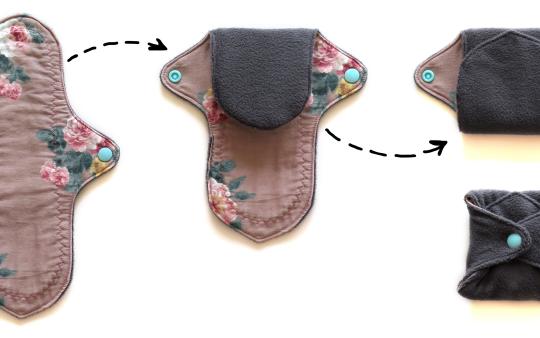Period. There. It’s been said.
Let's face it: our monthly periods literally help make the world go round and it’s no wonder that the feminine hygiene sector is a multi-billion-dollar industry. Each month, most of us are creating personal mountains of used pads or tampons—avoidable waste that each and every period-having-female on the planet contributes to. And sure, kudos to the fact that we have so many options, but those choices can be overwhelming, especially if you’re concerned about the chemicals used in the products and their impact on your body and the environment. It’s time think about period products that are more eco-friendly and less toxic for our bodies.
Conventional period products are bad for your health
It’s not a secret that conventional disposable pads and tampons are full of chemicals and polymers designed to aid in superior absorption and leak protection. How else could they work so well at keeping their users dry and leak-free? Many hygiene products also contain fragrances, gels, and chlorine bleach, not to mention the carcinogens, chemical by-products, and pesticides. And if that wasn’t enough to make you rethink the products you’re using, most contain BPAs and plastics that don’t compost. Basically, a conventional pad or tampon contains a toxic stew that you are giving unfettered access to your delicate parts and very permeable skin each month.
When you look at it that way, it’s pretty shocking that these products are not only allowed to be on store shelves but are touted as the only option for women to successfully make it through their monthly period. Amazingly enough, manufacturers of hygiene products for women are not required to share their ingredients. It’s considered proprietary and therefore secret. Even though those secrets could be making women sick.
Ditching disposables creates a healthier planet
It is believed that the average woman will generate 300 pounds or so of landfill waste from her period alone. That is a lot of tampons.
We have been raised in a society of disposables and the harmful concept of “out of sight, out of mind.” But the convenience of disposables is undermined when we realize that just because we’ve thrown something away doesn’t mean it’s really gone. Our overstuffed dumps and junk-riddled oceans are testament to the fact that garbage can’t be reabsorbed into the earth. Have you ever seen video footage from a waste-water treatment plant? Brace yourself.
The nasty reality about disposable pads and tampons is this: The same pads your mom used 40 years ago are still sitting in a landfill somewhere. (Gross. And true.) It can take something like 400 years for plastic to decompose, so the pad you toss out today will still be chilling in a landfill in 2418. You do not want to go back to that future!
4 Eco-Friendly Period Products
Considering half the world’s population is female and more than half of many women’s lives involves a monthly menstrual cycle, why should the search for eco-friendly period options that are safe and chemical-free be so difficult?
Never fear! Greener period options are becoming more accessible. There are some fabulous eco-products out there that are creating open and honest dialogues with their customers by disclosing all the ingredients in their products and by building communities of like-minded people.
Reusable pads
Reusable pads are not medieval torture traps involving belts and bunchy fabrics that itch. They’re cute and colourful, and they have little snaps that hold the pad securely in place. And best of all, they work! Yes, we all have lives and can’t stay home for the duration of our periods (which—not gonna lie—would be pretty awesome!) Reusable pads can definitely cut it in the real world. If you need to change your pad, simply bring along a wet bag (a smaller version of the ones used for cloth diapers). Once you get home, toss your pads in the wash, and you’re done.
Do reusable pads and underwear actually work at stopping leaks? Let’s be real here for a moment: disposable pads and tampons probably “work better” than the reusable pads. In the same way that disposable diapers work better than cloth. But the processes by which disposable products are made make them far more dangerous to our bodies. So, sure, a paper-thin pad with wings and that magic blue strip that claims to channel wetness wins the overall absorbency contest. But the cost of those chemicals leaching into your skin and the amount of waste pollution they create are a big price to pay for the convenience of disposal and a few extra hours of leak protection. The takeaway is this: Reusable pads and undies get you in tune with your body, have fewer chemicals, and don't pile up in the landfill. Change them a bit more often, layer the inserts if necessary, and don’t spend time worrying about toxins.
Period panties
Period panties are absorbent underthings that can hold up to two tampons-worth of menstrual blood, without looking (or feeling!) like a diaper. These typically have an absorbent panel sewn right into them, which means one pair of underwear can act as a replacement for disposable pads and tampons!! Some even come with the ability to add inserts, so just one pair of panties can go all day long! Like the reusable pads, these undies are made using a combination of organic cotton, spandex, and PUL (polyurethane laminate), depending on the style you choose. These companies often provide a material list for each pair of underwear they offer!
Menstrual cups
Menstrual cups are made out of silicone or rubber, meaning no nasty chemicals potentially being absorbed by you. They are inserted, like a tampon, and changing the cup is easy: simply dump and rinse. But (and this is probably the game changer for many women making the switch) unlike a tampon, there is no concern over toxic shock syndrome (TSS) and menstrual cups can be worn for up to 12 hours straight. You heard right: Twelve. Hours. Straight.
Yes, there’s a learning curve. Some people get it right away. Some people take a while to figure out the subtle nuances of a menstrual cup. But once you work it out, you’ll be amazed at the results. It’s also not as "convenient" as tossing a tampon and privacy may be a slight issue, like when you have to change them in a public washroom. But that twelve hours of flexibility means that there’s a good chance you’ll get some privacy somewhere along the line. Or, dump it, wipe it with some tp, stuff it back into its handy bag, and carry around a clean back up for when you can’t get to a private location.
Disposable hygienic products
Disposable hygienic products that are biodegrade, compostable, sustainably sourced, ethically produced, and environmentally-friendly exist! Look for pads and tampons that are certified organic, free of bleaches, dyes, synthetic ingredients, petroleum derivatives, perfumes, and plastics. Some brands are certified by MADE SAFE, a stringent scientific seal that ensures that consumer products are free of known toxic chemicals.
Love it or hate it, your monthly period is a pretty amazing system: it’s all a part of this self-cleaning, self-regulating, potential baby-incubating organ. Sure, the cramps are the worst, as are the weird hormonal surges, cravings, headaches, annoying acne, and bloating. But choosing the best product for you doesn’t have to be one more pain-in-the-month.
No matter which product you choose, let's start the conversation about period products that create less waste. The more we talk about it, the more companies will have to rise to the challenge of manufacturing greener, cleaner, and chemical-free products that are safe both for us and the earth. Make the choice to be kinder to your body and your world.
You may also enjoy: Eco-Friendly Period Products That Are Naturally Better and Why You Should Choose Eco-Friendly Period Products.






